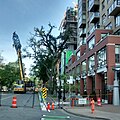History
Early bike lanes in Halifax include those on Bell Road, Brunswick Street, and South Park Street. The 1999 addition of a third lane to the Angus L. Macdonald Bridge also included the construction of a dedicated bikeway crossing Halifax Harbour. [1]
The city's first bicycle plan, Blueprint for a Bicycle Friendly HRM, was approved by council in 2002. It was superseded in 2006 by the Active Transportation Plan, which was updated in 2014 (see below). [2]
"AAA" bikeway network
In 2014, the Halifax council approved the Making Connections: 2014-19 Halifax Active Transportation Priorities Plan. The plan was developed with extensive public participation. Among respondents, the most popular concept mentioned was the construction of a bicycle network in the regional centre (defined as the Halifax peninsula and the area of Dartmouth within the Circumferential Highway). The plan identified several goals including developing a connected bicycle network, doubling the modal share of bicycles by 2026, and improving bicycle infrastructure by introducing new types of facilities such as protected bike lanes. [2]
A 2016 survey found significant interest among Halifax residents in cycling more often, but respondents wished for greater separation from motor traffic. The city aims to capture this "latent demand" by improving cycling infrastructure and increasing the share of trips made by bicycle. [3]
Overall transportation improvements in Halifax are guided by the Integrated Mobility Plan (IMP), which was approved by council in December 2017. As part of the IMP, the city is currently building an "all ages and abilities bikeway network" in the regional centre, commonly called the "AAA network". [3] "All ages and ability" bicycle infrastructure is defined as facilities that are "comfortable for a wide range of cycling abilities and experience levels". Guidance on the design of this type of infrastructure is provided by organisations such as the National Association of City Transportation Officials (NACTO) and the Transportation Association of Canada (TAC). [3]
The AAA network comprises around 57 kilometres (35 mi) of routes intended to form a comprehensive cycling network in the regional centre. [4] About 10 kilometres (6.2 mi) of the routes already met "AAA" standard, such as the Macdonald Bridge bikeway. [3] In addition to new cycling infrastructure, the project will include the upgrading of some existing routes. For example, conventional bike lanes on Hollis, Lower Water, and South Park streets are being upgraded to protected bikeways.
In July 2019, the project received $25 million in funding from all three levels of government. It was expected to be completed by 2022. [5] However, as of 2022 it was only around 40 per cent complete. [6]













